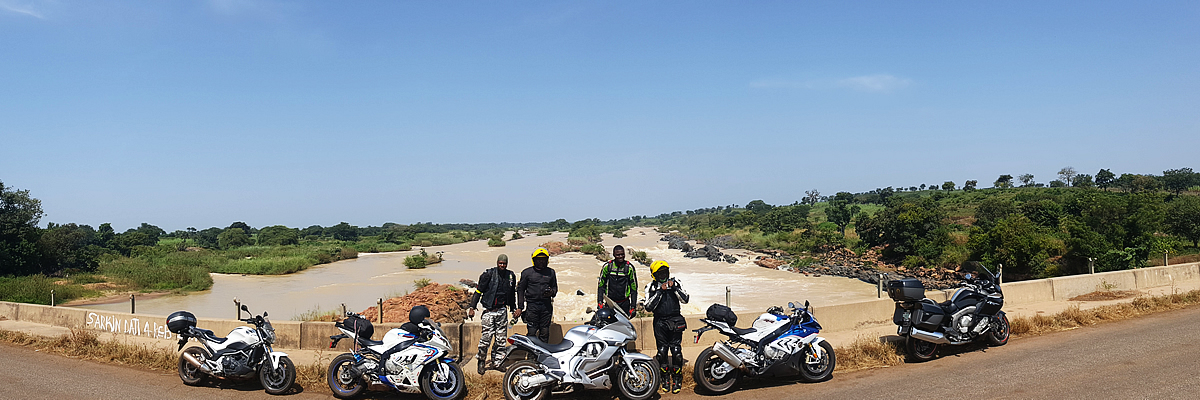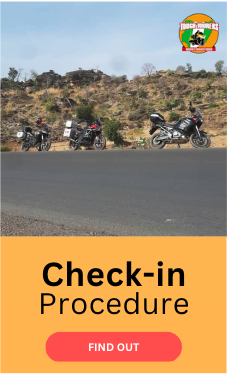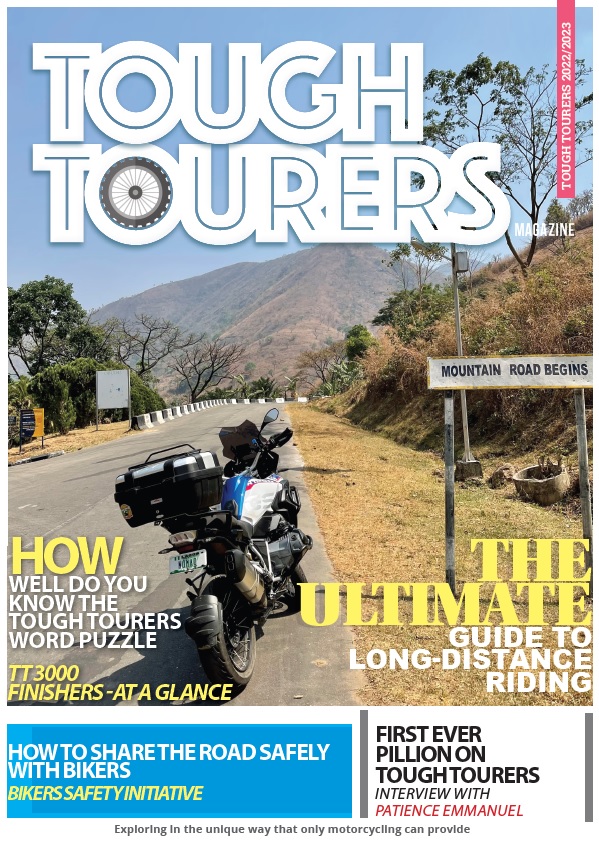
Riders who are successful in moto touring follow some basic “tricks of the trade”.
Here are some to get you revved up and going. This list is in no way exhaustive, and we welcome your contributions too!
Ride your own ride
All rides, trips and tours are designed to be fun, so there’s really no need to get competitive. Aim to finish, because only the finishers get the recognition 😉.
Knowing your personal and individual limits is key to “riding your own ride”, and you might need some discipline to stick to them. If you plan to ride 400km a day, then that’s fine.
Don’t give into the temptation to bend the rules to your favour.
It’s All In The Details
Having chosen the ride, you need to plan. What route are you going to take? What is the condition of the road? Are you ready for what the road might throw at you? Do you have a plan B? Where will you make food and petrol stops? Where will you stop for the night? Will you need to take a rest break? Remember, if you can’t move forward, you can always go back to where you came from.
“Slow and Steady” beats “Fast that doesn’t Last”
High-speed riding comes with a completely different set of demands than long distance touring. It is advisable to maintain a steady, relaxed speed.
High-speed riding exposes you to a higher risk of collision on our Nigerian roads, and also places more demand on your bike’s tyres, fuel range and mental state. Fatigue sets in faster, and you make more fuel stops. Eventually, your average speed suffers, so much so that you might have as well gone “slower”.
Ride as fast as you can see, for the circumstances you are in. If you cannot stop in the distance you are seeing, then you are probably going faster than you ought to.
Avoid all drugs 🚫
This includes alcohol and/or energy drinks. If you feel you need these to remain alert or finish your ride plan for the day, then you need to stop NOW and get some rest! If you are feeling bored, then find something to do on the road to bring your mind back to focus. Some people listen to music, others lick a sweet or have an orange. Find out what works for you and stick to it. Remember, only finishers get the recognition!
Bike Check
Is your Bike ready for the trip? You have spent money and time to do this ride. You also need to make sure your bike can do it too. It is a lot easier, cheaper and convenient to do your repairs/changes at home than on the road. Resist the temptation to “squeeze” out some more mileage out of those tyres, because at the end of the day, you’ll end up spending more if you have “on-the-road repairs” that could easily have been avoided.
Don’t Go Nuclear With New Stuff!
Avoid riding with new gear (helmet, gloves, jacket, riding shoes etc), new add-ons to your bike (extra/new lights, “effizie” stuff, new tank bag etc) or riding immediately after a service. The best mechanics are still human and make mistakes. You don’t want to discover a nagging discomfort as a result of your new gear, or a loose bolt on day 2 of your Nigerian Cross Tour!
Use tested and trusted gear and spend a couple of days riding your bike around to work out any niggling issues that might arise before you hit your tour!
Avoid the temptation to buy stuff on the road. It adds to the things you need to carry and shows that perhaps you didn’t plan properly?
Don’t Wait To Hydrate! 💧
Heat and humidity are no friends to the long distance rider in Nigeria. Don’t wait till you are thirsty before you drink water. You might want to consider getting a hydration pack (like camelbak), which allows you drink even while riding.
It is worthy to note that when you sweat, your body is losing electrolytes, so perhaps some “sports drinks” might help – Lucozade Boost is not a bad way to go, but drinks MUST NOT replace water. A good water intake guide would be 1 litre of water for every 100km of travel It’s also a good idea to have an “emergency” bottle of water. You don’t want to add a lack of water to any problems you might encounter.
Pack Smart like a Smart Phone
Keep only the things you need and leave out things you won’t need altogether. The rule is that if you have space, you will fill it.
Don’t keep your vehicle papers under all your clothing in the bag that’s strapped to the back seat of your bike. Imagine the frustration as you search for it by the road side at the check point.
A good way to travel light is to use wicking technical underwear – shirts, ling johns, and socks.
You will not require more than a pair as you can wash at the end of day, and it would be dry by the next morning.
Keep your documents, cash, and phone in a water-tight bag (Zip-lock bags will also work), and save yourself a lot of time.
What’s The The Worst That Could Happen
What do you do if you have a breakdown? Having a plan can reduce your downtime tremendously. Assess the situation and make your decision fast. Is the breakdown something that can be fixed easily like a punctured tire? Do you need the bike to move or must you get help to the bike. Being a bike and in Nigeria, a viable option remains putting the bike in a truck and heading on. You might have to leave it by the road side and find your way to the next town to get help. However the case, bear in mind the time. It is not wise to be stuck on an empty road in the middle of nowhere with night or rain approaching.
Attitude is Everything
Maintain the right attitude. If you are worrying about the conditions around you more than you are concentrating on the road, then that’s a sure sign that something is not right. Bad weather can do that to you. It is better to stay put and let the weather pass, AND BE HAPPY, than to struggle with the rain, being miserable and hating on yourself. This is a distraction and offers no benefit whatsoever.
Attention! Be Alert Always‼️
On long rides, it is common to experience fatigue. The signs are
– Inability to maintain a desired speed. If you find yourself slowing down and constantly having to speed back up, you are ready to fall asleep!
– Figthing with the thought of “closing your eyes” even for one second!
– Forgetting to turn off your blinkers.
– Your lane indiscipline becomes more obvious and you find it difficult to maintain your line in a curve.
– You start having indecision battles in your mind; where do I stop? Do I stop? Can’t decide to stop for petrol or continue? Can’t decide what turn to take?
All these are signs of fatigue. Stop and take a nap or a rest… DO NOT push yourself.
Before It Comes Pouring Down ⛈
Rain gear should go on before it starts raining. Having a look at the weather forecast for the day is not a bad idea and most smart phones have that feature. Prepare yourself and avoid “braving” the elements. The chills you can get from riding wet can easily lead to pneumonia or other respiratory tract infections. When making stops like this, be sure to move well off the road and be as considerate to other road users as is safe to do so.
Kill Three Birds With One Stop
Use your stops efficiently, such that you can get as many things done in one stop as possible. If you’re making a stop for petrol, you might as grab a bite and respond to nature’s call. Try to stay away from unfamiliar food on the road. Worst case scenario, you can stay safe by eating biscuits and taking soft drinks. You can always make up for it later with a good meal in the hotel at your night stop, rather than dealing with unnecessary “toilet” stops 😉
Meds To Go
It’s a good idea to take multivitamins on your trips. Along with your basic pain killers like paracetamol, aspirin can also be considered. Alabukun is a popular Nigerian brand. It is very effective for aches and pains. Bear in mind the side effects and your body’s tolerance when making the choices on what to stock.
Road Safety
Avoid riding alongside, in front of or behind a truck and other large vehicles. Motorcyclists are “unseen” at the best of times. Around these large vehicles, this just gets worse. Moreover, the danger from a tyre blowout or debris falling off the truck adds to the problems. Avoid being in this situation.
Staying Comfy
During long rides, rider discomfort could create so much stress that is could become outrightly dangerous. The discomfort created from wearing inappropriate gear or being in an “uncomfortable” riding position gradually eats away at a rider’s concentration, so any money spent on making yourself more comfortable is money well spent.
Below are a few tips to staying comfortable.
Consider your seat: When you spend a long time sitting on your bike, it is your butt that bears the brunt. An air cushion like “Air Hawk” is a solution worth considering. However, know that if it is not properly sized and inflated with the “right” amount of air, it would be completely useless.
Some bikes offer higher seats. The higher your seat is from your foot pegs, the better it is for your knees! Lowering your foot-pegs is an alternative to a higher seat. The extra 1 or 2 inches you would get from getting yourself a set of lowered foot pegs, can be the difference between time spent massaging your knees and time spent enjoying your evening after your ride.
Avoid foot-pegs that are made of solid metal which don’t have the rubber foot hold. They transmit the bikes vibrations to you via your feet and increase your fatigue and discomfort.
Getting a more up-right position helps reduce the stress on your wrists and no matter where you think you are in your riding comfort, it can always get more comfortable.
Installing “Bar risers” or “Helibars” is the way to go for that little extra comfort, as they tend to help get a more upright position by bringing the handle bars higher and closer than the stock position.
Your Underwear Can Reduce Your Getting Weary: Technical underwear is expensive, but the pain and discomfort from riding without these could be even more so. From the right socks to “long-Johns” to wicking shirts to balaclavas or tubes, the right underwear will keep you dry and prevent your skin from chaffing.
No more smelly helmets or boots. No more “monkey butt” too. Sitting for long periods of time in your sweaty cotton boxers or padded shorts causes your skin to chaff. It’s a common occurrence with babies and we call it diaper rash. For riders, it can be so uncomfortable. But we are all not the same, and even with the best wicking underwear, some chaffing still occurs.
Neosporin cream will work wonders during your night stop. Its antibiotic action along with the pain relief will help soothe and heal your bum and get you ready for the next day!
Screening Yourself: Protecting yourself from the elements will not only keep your gear clean, but will keep reduce the fatigue from exposure. An after-market windscreen or "touring" screen can make the difference. But remember, some screens are so "good" that it can get quite "hot" behind them. Do some research and be willing to spend money on a product that gives you flexibility.



